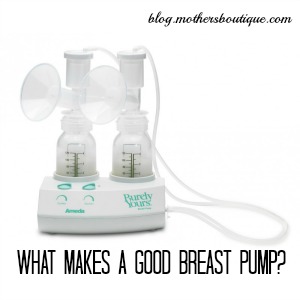Many women with a good health insurance plan are able to purchase a double-electric breast pump through their insurance at no cost to them. This is fantastic!
Except that many insurance plans are only covering a low-end pump that many lactation consultants refer to as “mastitis machines.” This widely-sold pump is so infamous for causing issues that the company has, thankfully, planned to stop making it. Unfortunately, this pump might be the only insurance option for moms for a while longer…
So. What can you do? If feeding your baby your expressed breastmilk is important to you, purchasing a quality pump to express this milk makes financial sense. A proper pump will help you avoid mastitis, maintain your supply, and feed your baby while you are separated.
We know it’s a large expense, so we want to make sure you know what to look for before you invest.
Closed System. A closed system pump means that contamination can not get into the pump motor or into your milk. In a closed system pump, the milk never contacts the motor, and the motor never contacts the milk. Other pumps are open system and can grow mold inside of the motor and can get contamination inside of your milk. The Ameda and Hygeia pumps are the only pumps that are CLOSED systems.
Suction. A good breast pump should generate between 220-275 mmHg suction. We are able to test your pump motor efficiency in our shop locally–most small businesses selling breast pumps should be able to test your pump for you to determine whether yours is generating proper suction. Our personal pumps generate between 225-250 mmHg, while hospital grade pumps have an even stronger motor.
Easily-changed accessories. Valves, tubing, flaps–these parts of your breast pump should be changed regularly, and changing them should be easy for you. Some manufacturers have different accessories for each different model, which can be confusing if you’re trying to order replacement parts in a hurry. We sell Ameda pumps, which all use the same accessories, from the hospital grade platinum models to the manual pump. Ameda has not switched their design, so today’s accessories still fit last year’s pump.
When purchasing a pump, make sure you know what parts you need and how to order them if they’re not sold in the same store as the pump.
Custom-sized flanges. Not all nipples are size medium, yet that’s the size flange that comes standard with breast pumps. A woman’s breast and nipple size can fluctuate through her nursing career, or even through the month as her cycle returns! A good pump offers a variety of flanges to make sure you get the best “latch” you can with your pump and maximize your output. Here’s a great chart with pictures to help you figure out which size you might need.
We know a great many of you will return to work while your baby is still breastfeeding, and a good pump can help to make sure you’re able to maintain your nursing relationship. Hopefully this information makes it easier for you to weigh your options.
Did you purchase your breast pump out of pocket to avoid a low-quality insurance pump? Leave us a comment to share how you made your decision.











Wow, I had no idea that breast pumps could differ so much from one another. My wife and I are having our first baby. We are very excited for the new arrival. We have been trying to get everything ready before the baby comes. I think I will go with a closed system for the breast pump. I do not even care if it costs more. I just want to keep my wife and the baby healthy and happy.